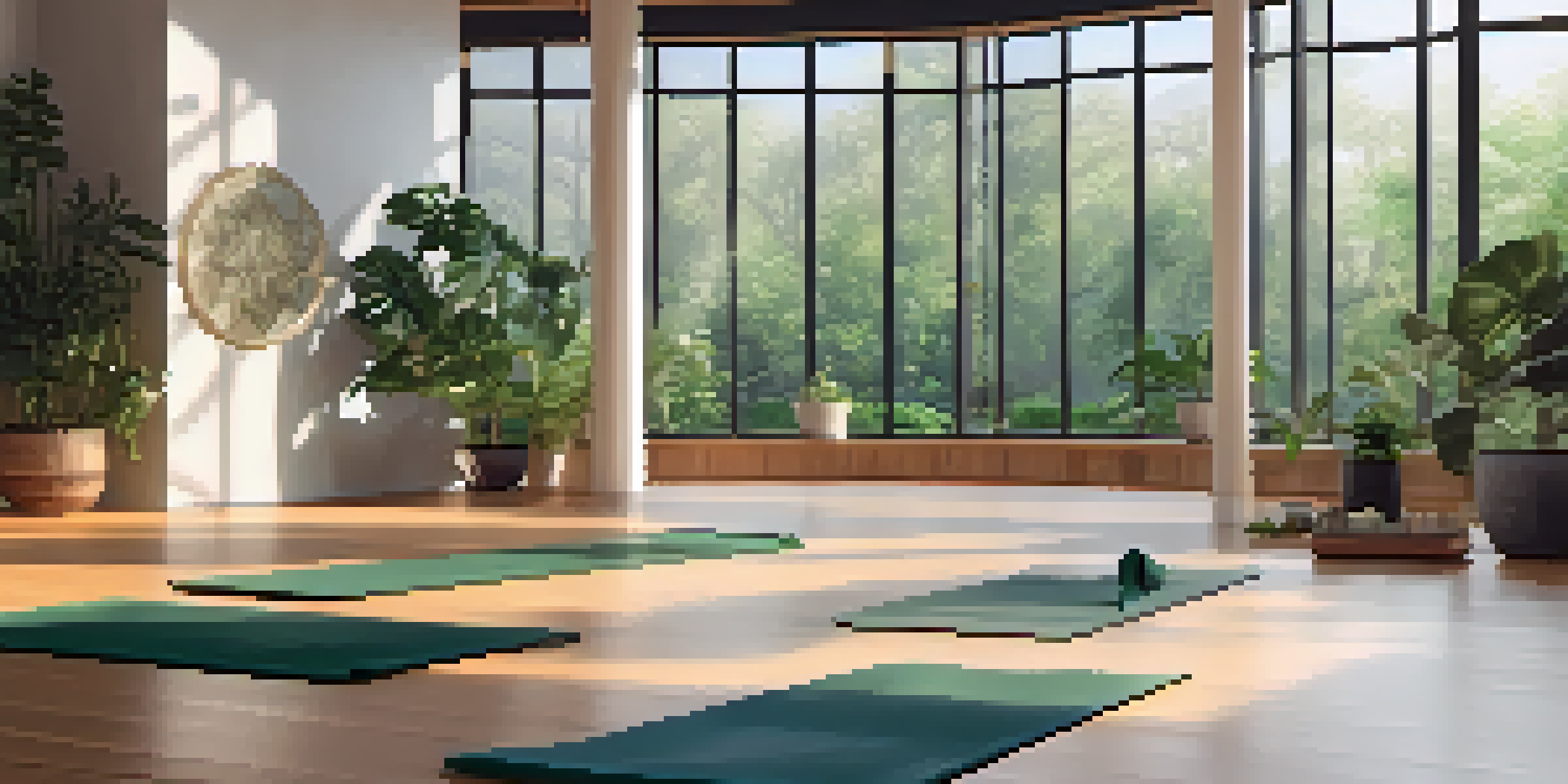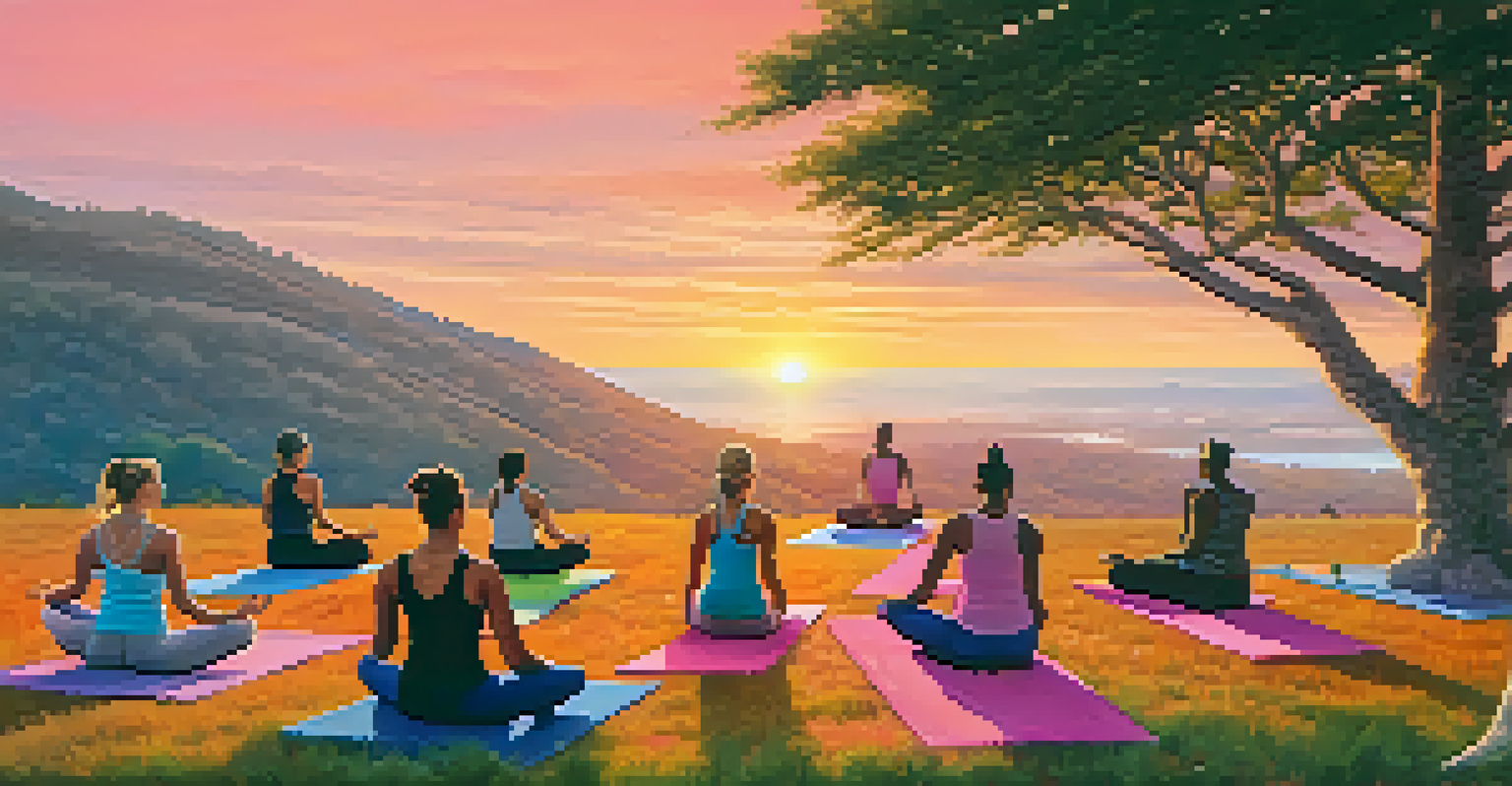A Beginner's Guide to Yoga for Overall Physical Fitness

What is Yoga and Its Benefits for Fitness?
Yoga is an ancient practice that combines physical postures, breathing techniques, and meditation. It's not just about stretching; it's a holistic approach to fitness that nurtures both body and mind. The benefits of yoga extend far beyond the mat, promoting improved flexibility, strength, and overall well-being.
Yoga is the journey of the self, through the self, to the self.
One of the most appealing aspects of yoga is its adaptability. Whether you're a complete beginner or an experienced athlete, there are various styles and levels to suit your personal needs. This inclusivity makes yoga an excellent choice for anyone looking to enhance their physical fitness.
Incorporating yoga into your routine can lead to increased energy levels and reduced stress, which is vital for maintaining a healthy lifestyle. Think of yoga as a toolkit that equips you with the tools to manage physical challenges while cultivating a sense of inner peace.
Getting Started: Essential Yoga Gear for Beginners
When embarking on your yoga journey, having the right gear can make all the difference. A good-quality yoga mat is essential for providing grip and cushioning, ensuring you can focus on your practice without distractions. Additionally, comfortable clothing that allows for movement is important, as it helps you feel free and relaxed during your sessions.

You might also consider props like blocks, straps, and bolsters, especially if you're new to certain poses. These tools can assist with alignment and make challenging postures more accessible. Remember, investing in your yoga gear is an investment in your fitness journey.
Yoga Enhances Physical Fitness
Yoga is a holistic practice that improves strength, flexibility, and overall well-being.
Lastly, don't forget about water! Staying hydrated before and after your practice helps keep your body functioning optimally. With the right gear and mindset, you’re set to dive into the world of yoga.
Finding the Right Yoga Style for Your Fitness Goals
Yoga comes in many styles, each offering unique benefits that can align with your fitness goals. For example, if you're looking to build strength, power yoga or vinyasa might be ideal, as they involve dynamic movements that engage multiple muscle groups. On the other hand, if flexibility is your primary focus, styles like yin yoga or hatha may serve you better.
Inhale the future, exhale the past.
It's essential to explore different styles to find what resonates with you. Some individuals thrive in the calming environment of restorative yoga, while others prefer the energetic flow of ashtanga. Don't hesitate to try a few classes before settling on your favorite.
Remember, the goal is not to master every style but to find what feels good in your body. Yoga is a personal journey, and discovering your preferred style is a significant step towards achieving your overall fitness goals.
Basic Yoga Poses to Kickstart Your Practice
As a beginner, familiarizing yourself with some foundational yoga poses is crucial. Poses like Downward-Facing Dog, Warrior I, and Child's Pose are great starting points. These basic poses help build strength, improve flexibility, and can be easily modified to suit your level.
Practicing these poses regularly will not only enhance your physical fitness but also boost your confidence on the mat. Each pose offers its own set of benefits, and as you progress, you’ll find increased ease and comfort in each position.
Mindfulness Boosts Your Practice
Incorporating mindfulness into yoga fosters a deeper awareness of your body and emotions, enhancing both physical and mental health.
Remember, it's important to listen to your body and avoid pushing yourself too hard. Yoga is about finding balance and harmony, so take your time to understand each pose and how it feels in your body.
Incorporating Breathing Techniques into Your Yoga Practice
Breathing techniques, or pranayama, play a vital role in yoga and overall fitness. These exercises help increase lung capacity, reduce stress, and improve focus, making your practice more effective. Learning to control your breath can transform your yoga experience, allowing for deeper stretches and improved endurance.
For instance, practicing Ujjayi breath involves inhaling and exhaling through the nose while constricting the throat slightly. This technique not only calms the mind but also helps maintain a steady rhythm during your practice, enhancing your ability to flow through poses.
Incorporating these breathing techniques into your routine can lead to better physical performance and a greater sense of relaxation. As you develop this skill, you might discover it positively impacts other areas of your life, too.
Creating a Consistent Yoga Routine for Fitness
Establishing a consistent yoga routine is key to reaping its fitness benefits. Start with short sessions, perhaps 20-30 minutes a few times a week, and gradually increase the duration as you become more comfortable. The most important aspect is to make yoga a regular part of your life, rather than an occasional activity.
Consider scheduling your yoga sessions like any other appointment. Whether it’s a morning practice to energize your day or an evening session to unwind, find a time that suits your lifestyle. Consistency will help your body adapt and strengthen over time.
Consistency is Key to Success
Establishing a regular yoga routine helps you maximize its fitness benefits and adapt over time.
Remember, it’s okay to have off days. The key is to be kind to yourself and keep showing up. Each practice is a step forward on your fitness journey, no matter how small it may seem.
Mindfulness and Yoga: Connecting Body and Mind
Yoga isn't just about physical fitness; it’s also a powerful tool for cultivating mindfulness. By focusing on your breath and the sensations in your body, you can develop a deeper awareness of your thoughts and emotions. This connection between body and mind can enhance your overall well-being and fitness journey.
As you practice, try to observe your thoughts without judgment. This mindfulness can help reduce anxiety and stress, factors that often hinder physical fitness. When you're present in the moment, you're more likely to listen to your body and respond to its needs.

Incorporating mindfulness into your practice can turn yoga into a holistic experience, enriching both your physical and mental health. Over time, you may find this awareness spills over into other aspects of your life, leading to a more balanced lifestyle.